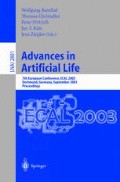Abstract
Turn-taking behaviour is simulated with a coupled agents system. Each agent is modelled as a mobile robot with two wheels. A recurrent neural network is used to produce the motor outputs and to hold the internal dynamics. Agents are developed to take turns on a two dimensional arena by causing the network structures to evolve.
Turn-taking is established using either regular or chaotic behaviour of the agents. It is found that chaotic turn-takers are more sensitive to the adaptive inputs from the other agent. On the other hand, regular turn-takers are comparatively insensitive to noisy inputs due to their restricted dynamics. From various observations, including turn-taking with virtual agents, we claim that the chaotic turn-taking agents become less robust when coping with virtual agents but at the same time, those agents are more adaptable to each other than the regular turn-taking agents. All these findings are discussed and compared with Trevarthen’s double monitor experiments.
Access this chapter
Tax calculation will be finalised at checkout
Purchases are for personal use only
Preview
Unable to display preview. Download preview PDF.
References
Cliff, D., Miller, G.F.: Co-evolution of Pursuit and Evasion II: Simulation Methods and Results. In: Proceedings of the Fourth International Conference on Simulation of Adaptive Behavior(SAB 1996), From Animals to Animats 4, pp. 506–515. MIT Press Bradford Books (1996)
Dautenhahn, K.: Embodiment and interaction in socially intelligent life-like agents. In: Nehaniv, C.L. (ed.) CMAA 1998. LNCS (LNAI), vol. 1562, pp. 102–142. Springer, Heidelberg (1999)
Di Paolo, E.A.: Behavioral coordination, structural congruence and entrainment in a simulation of acoustically coupled agents. Adaptive Behavior 8(1), 25–46 (2000)
Ikegami, T., Taiji, M.: Structures of Possible Worlds in a Game of Players with Internal Models. Acta Polytechnica Scandinavica Ma. 91, 283–292 (1998)
Ikegami, T., Taiji, M.: Imitation and Cooperation in Coupled Dynamical Recognizers. In: Advances in Artificial Life, pp. 545–554. Springer, Heidelberg (1999)
Ikegami, T., Morimoto, G.: Chaotic Itinerancy in Coupled Dynamical Recognizers. Journal of American Institute of Physics (submitted)
Ikegami, T., Iizuka, H.: Joint Attention and Dynamics Repertoire in Coupled Dynamical Recognizers. The Proceedings of Imitation in Animals and Artifacts II (2003)
Iizuka, H., Ikegami, T.: Simulating Turn-taking Behaviours with Coupled Dynamical Recognizers. In: Standish, R., et al. (eds.) The Proceedings of Artificial Life 8, pp. 319–328. MIT Press, Cambridge (2002)
Reynolds, C.W.: Competition, Co-evolution and the Game of Tag. In: Brooks, R.A., Maes, P. (eds.) Artificial Life IV, pp. 59–69. MIT Press, Cambridge (1995)
Scassellati, B.: Imitation and mechanisms of joint attention: A developmental structure for building social skills on a humanoid robot. In: Nehaniv, C.L. (ed.) CMAA 1998. LNCS (LNAI), vol. 1562, p. 176. Springer, Heidelberg (1999)
Trevarthen, C.: Descriptive Analyses of Infant Communicative Behaviour. In: Schaffer, H.R. (ed.) Studies in Mother-Infant Interaction. Academic Press, London (1977)
Trevarthen, C.: The Self Born in Intersubjectivity: The Psychology of an Infant Communicating. In: Neisser, U. (ed.) The Perceived Self, pp. 121–173. Cambridge University Press, Cambridge (1993)
Author information
Authors and Affiliations
Editor information
Editors and Affiliations
Rights and permissions
Copyright information
© 2003 Springer-Verlag Berlin Heidelberg
About this paper
Cite this paper
Iizuka, H., Ikegami, T. (2003). Adaptive Coupling and Intersubjectivity in Simulated Turn-Taking Behaviour. In: Banzhaf, W., Ziegler, J., Christaller, T., Dittrich, P., Kim, J.T. (eds) Advances in Artificial Life. ECAL 2003. Lecture Notes in Computer Science(), vol 2801. Springer, Berlin, Heidelberg. https://doi.org/10.1007/978-3-540-39432-7_36
Download citation
DOI: https://doi.org/10.1007/978-3-540-39432-7_36
Publisher Name: Springer, Berlin, Heidelberg
Print ISBN: 978-3-540-20057-4
Online ISBN: 978-3-540-39432-7
eBook Packages: Springer Book Archive

